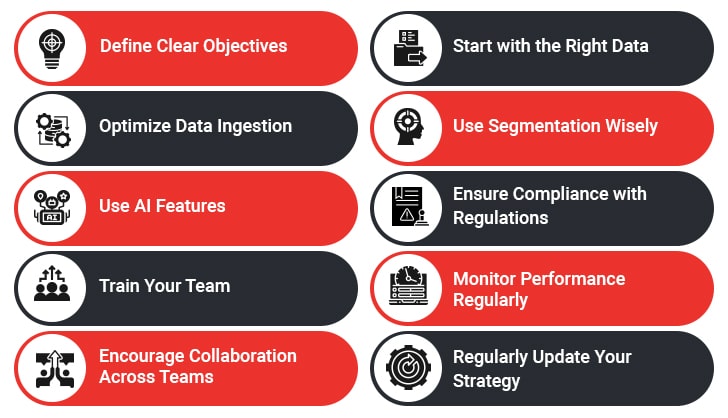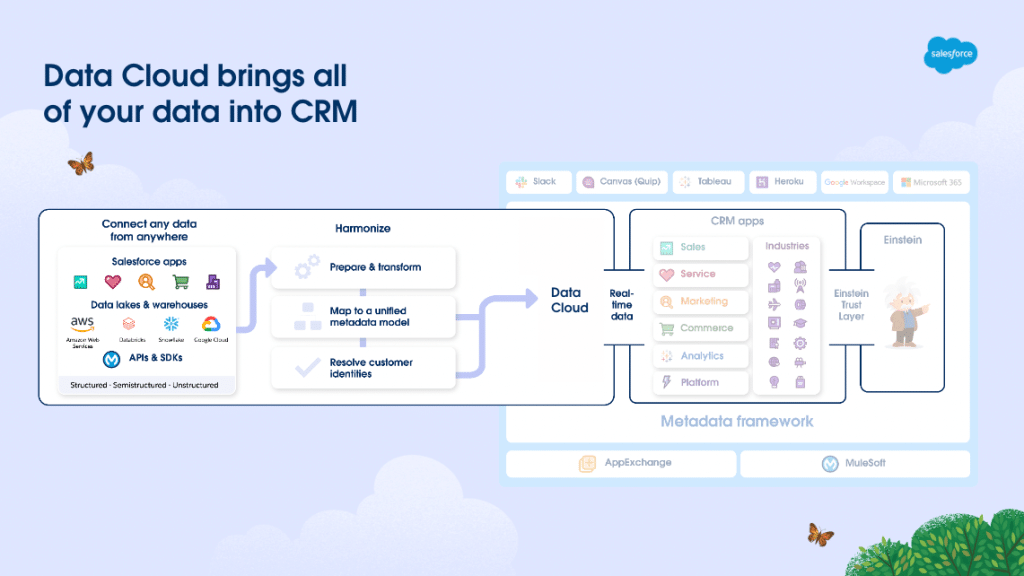80% of customers expect better customer experiences based on the data the companies collect. However, most of the companies struggle with getting the most out of fragmented data accrued by different systems in the organization. To address these data management challenges, Salesforce has come up with Salesforce Data Cloud. It’s a robust platform that centralizes customer data from multiple sources. It’s built with the power of AI, Data, and CRM. By establishing a single source of truth, it helps businesses to provide outstanding customer experiences in sales, service, marketing, and commerce as well as timely actionable insights.
The Data Cloud comes with innovative features to boost data usability across the platform services and applications of Salesforce CRM. With the help of features like Data Cloud Triggered Flows and Data Cloud Related Lists, the data cloud makes it possible to view customer engagement data from a website on every customer record in Salesforce.
Using Data Cloud, you can connect data from any source and utilize it within applications that business users depend on for daily operations. This is made feasible since Salesforce data cloud architecture is built on the foundational metadata layer of Salesforce, offering a common language that integrates all Salesforce apps and low-code platform services.
Salesforce Data Cloud: Key Features
Disconnected data hampers important customers-facing tasks like improving customer experience. The powerful combo of data and CRM allows customers to create richer, and more tailored customer experiences. All this data can be connected in real time to Salesforce’s Einstein AI capabilities, which enable generative AI and predictive insights to be fueled by reliable company data.
Key features of Data Cloud include the following:
1. Unified Customer Profiles
Salesforce Data Cloud helps create complete customer profiles by gathering data from different places. This makes it easier for businesses to better understand their customers. With all the details in one place, companies offer services that fit each customer’s needs. For example, if a customer has shown interest in certain products before, businesses may suggest similar ones. This helps build better relationships and increases customer satisfaction.
2. Integrated Data
One great feature of Salesforce Data Cloud is that it combines data from many sources easily. This includes data from CRM systems, marketing tools, and social media. By collating all this data together, businesses access the most accurate information which helps them make better decisions. Furthermore, this integration ensures that everyone has the latest information, which is crucial for effective marketing and customer service.
3. Advanced Analytics
Salesforce Data Cloud has strong tools to help businesses understand their data better. These tools find trends and predict future outcomes using AI. For example, businesses may look at past customer data to predict what they might want to buy next. Using these insights helps companies make smart choices that improve their strategies and overall performance.
4. Data Security and Compliance
Keeping data safe is the top priority for Salesforce Data Cloud. The platform has strong security features to protect sensitive data. It also helps companies follow industry laws about data privacy by providing tools to manage consent and privacy. This focus on security keeps customer data safe while allowing businesses to work confidently.
5. Scalability
Salesforce Data Cloud grows with your business. As your data needs increase, the platform scales accordingly to manage larger volumes of information without slowing down. This means you may continue using data cloud as your business grows or adds new services.
6. Data Enrichment
Salesforce Data Cloud lets companies add more information to their existing data from different sources. This means companies get updated contact details and other important data that helps them understand customers better. Having exhaustive data allows companies to craft better marketing campaigns and improve customer engagement.
7. Real-Time Data Updates
The platform gives real-time updates on customer information, so businesses always have the latest details available. This feature is especially important for companies with rapidly changing customer details or market conditions. Real-time updates allow teams to respond quickly to changes and maintain effective communication with customers.
8. AI-Powered Insights
Salesforce Data Cloud uses artificial intelligence to give helpful insights based on data analysis. AI finds patterns in customer behavior and suggests what actions to take next. These findings help businesses make better decisions and improve their strategies.
9. Market Segmentation Capabilities
Salesforce Data Cloud helps businesses group customers based on different factors like age or buying habits. This grouping allows companies to create marketing messages that are more relevant to specific groups, leading to better engagement.
10. Event Marketing Support
Businesses use Salesforce Data Cloud for event marketing by easily making lists of attendees for conferences or webinars. The platform helps ensure that invitations go to the right people based on their interests.
11. Customer Relationship Management Integration
Salesforce Data Cloud works well with Salesforce CRM systems, adding more data insights to customer profiles. This integration helps teams engage better with customers by providing a comprehensive view of all interactions across different touchpoints.
12. Customizable Dashboards
Salesforce Data Cloud offers dashboards that users may customize to see important metrics easily. These dashboards give quick access to key information about customer behavior and sales performance.
13. Easy Data Management Tools
The platform includes simple tools for managing data quality within Salesforce Data Cloud. Users may clean records, remove duplicates, and standardize formats easily, ensuring the data stays accurate for making decisions.
Unify Your Data, Empower Your Business—
Best Practices for Using Salesforce Data Cloud
These best practices help organizations effectively utilize Salesforce Data Cloud while achieving their objectives efficiently and responsibly.

1. Define Clear Objectives
Before using data cloud, it’s important to set clear goals for what you want to achieve. Talk to everyone involved to understand their needs. This could mean improving customer experiences or making data management easier. Having specific goals helps you use the platform effectively. For example, if you want to improve customer segmentation, the focus should be on analyzing relevant data. This helps you devise marketing campaigns that drive results. Clear goals help guide your strategy and keep everyone on the same page.
2. Start with the Right Data
The success of a data cloud implementation depends on the quality of the data you input. Before moving data into the system, check that it is accurate and complete. Clean your data by removing duplicates and fixing errors. Good quality data leads to fast and better decisions. Set up a process to regularly check and update your data to keep it accurate.
3. Optimize Data Ingestion
When importing data into SDC, it’s important to optimize the ingestion process. Only import the data that is necessary for your operations to avoid cluttering your system with irrelevant information. Consider aggregating data before ingestion, which helps reduce the volume of records while still providing valuable insights. For example, instead of importing every detail of each transaction, you may group sales data by month. This approach not only speeds up the ingestion process but also makes it easier to analyze trends over time.
4. Use Segmentation Wisely
Segmentation lets you group customers based on various criteria in Salesforce Data Cloud. When creating these groups, choose the right factors to ensure accuracy. For example, using a complete customer profile may help avoid duplicates. Limit the amount of data processed during segmentation to improve performance. This can be achieved by applying filters or using data spaces to organize information logically.
5. Use AI Features
Salesforce Data Cloud has AI tools that help you analyze your data better. Use these tools to understand customer behavior and market trends more deeply. For example, predictive analysis helps forecast future sales based on past patterns. By using AI features, businesses make more informed decisions and devise strategies that align with their audience.
6. Ensure Compliance with Regulations
Data privacy regulations are important when handling customer information in data cloud. Make sure your organization follows laws like GDPR by managing consent properly. This means tracking how customer data is collected and used and giving customers options for managing their information.
7. Train Your Team
Training your team is important for getting the most out of the data cloud. Make sure all users know how to use the platform well. Provide resources like tutorials or workshops to help them learn the system. A well-trained team utilizes the platform’s capabilities. This leads to increased productivity and better outcomes for your organization.
8. Monitor Performance Regularly
Keeping an eye on how data cloud is performing is crucial for identifying the areas that need improvement. Track KPIs related to data use and customer engagement. Use this information to adjust your strategies or processes as needed.
9. Encourage Collaboration Across Teams
Encourage different teams in your organization to work together when using data cloud. Sharing insights and best practices helps everyone work better toward common goals. This improves communication and ensures that everyone is aligned in their efforts to serve customers better.
10. Regularly Update Your Strategy
As your business changes, update your strategy for using Salesforce Data Cloud too. Review your approach based on new market conditions or business goals and stay informed about new features that could help improve your operations. Being flexible and open to change will help you get the most out of SDC over time.
Connect Data, Drive Results.
Salesforce Data Cloud Use Cases Across Industries
These use cases illustrate how SDC provides valuable solutions across various industries.
I. Banking: Customer Segmentation
In banking, Salesforce Data Cloud can help banks segment customers based on their financial situations, preferences, and behaviors. By looking at this information, banks may create marketing campaigns that appeal to specific groups. For example, if a bank finds customers interested in home loans, they may send them special offers. This targeted marketing helps engage customers and makes them happier. Understanding what customers need better also helps banks improve their services and keep clients loyal.
II. Manufacturing: Customer Relationship Management
Manufacturers might utilize Salesforce Data Cloud to manage relationships with customers and distributors effectively. By centralizing data about interactions at every touchpoint, businesses can enhance communication and service delivery. For example, manufacturers can track orders and provide live updates on delivery status to customers. This transparency improves customer satisfaction while allowing manufacturers to forecast demand accurately.
III. Education: Student Engagement Tracking
Schools might leverage Salesforce Data Cloud to track how engaged students are and how well they are doing. By collating data from different systems, schools can identify students who require extra help. For example, if a student struggles with chemistry or physics, teachers might offer tailored tutoring sessions on those specific subjects to support them.
IV. Healthcare: Unified Patient Profiles
In healthcare, SDC can help create comprehensive patient profiles by combining data from sources. This would give healthcare providers a better understanding of their patients, so that they can offer tailored patient care. For example, healthcare experts might send health reminders based on individual patient histories. Unified profiles lead to improved patient engagement and better health outcomes.
V. Telecommunications: Churn Prediction
Telecom companies use the data cloud to predict when customers might leave by looking at their usage patterns. If they notice signs that a customer may switch providers—like using less service or complaining—they may take steps to retain them. For example, they might offer special deals or better service plans before the customer decides to leave.
VI. Ecommerce: Hyper-Personalized Product Recommendations
In retail businesses, Salesforce Data Cloud can help analyze customer behavior to suggest products that fit their interests. By tracking customer browsing history and past purchases (or historical data), an ecommerce company might suggest items that match their preferences. For example, if a customer often buys outdoor gear, the site might suggest new hiking equipment.
Conclusion
The Salesforce Data Cloud brings in a new era in data management by completely transforming how companies use and manage their data assets. Businesses can unleash new opportunities, promote innovation, and attain sustainable growth with the help of the Data Cloud’s advanced integration capabilities, AI-powered insights, improved collaboration tools, and powerful security features. With businesses continuing to navigate the complexities of the digital age, Salesforce-certified Data Cloud consultants stand as a beacon of hope, offering a comprehensive solution to their data management needs.






